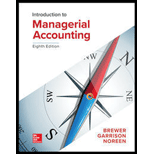
Cane Company manufactures two products called A1pia d Beta that sell for $120 and $80, respectively. Each product uses only one type of raw material that costs $6 per pound. The company has the capacity produce 100,000 units of each product. Its average cost per unit for each product at this level of activity are given below:
The company considers its traceable fixed manufacturing
Required:
(Answer each question independently unless instructed otherwise.)
Assume that Cane expects to produce and sell 80,000 Alphas during the current year. One of Cane’s sales representatives has found a new customer who is willing to buy 10,000 additional Alphas for a price of $80 per unit. What is the financial advantage (disadvantage) of accepting the new customer’s order?
Concept Introduction:
Financial advantage (disadvantage): Financial advantage (disadvantage) refers to the incremental profit or loss, a company will earn in situations like acceptance of a special order, dropping of a business line, etc.
It is calculated by only considering the relevant costs. The incremental revenues and incremental costs are taken together to calculate financial advantage or disadvantage. Financial advantage refers to incremental net operating income and financial disadvantage refers to incremental net operating loss.
To calculate:
Financial advantage (disadvantage) of accepting the new customer’s order for Alpha
Answer to Problem 3F15
Solution:
The financial advantage of accepting the new customer’s order for Alpha is $ 110,000.
Explanation of Solution
The incremental net operating profit (loss) is the difference between incremental revenues and costs.
| Alpha - Incremental Net operating profit (Loss) (in $) | ||
| Incremental Revenue ( $ 80/ unit X 10,000 additional units) | 800,000 | |
| Less: | ||
| Incremental costs - | ||
| Direct material ( $ 30/ units X 10,000 additional units) | 300,000 | |
| Direct labor ( $ 20/ unit X 10,000 additional units) | 200,000 | |
| Variable manufacturing overhead ( $ 7/ unit X 10,000 additional units) | 70,000 | |
| Variable selling expenses ( $ 12/ unit X 10,000 additional units) | 120,000 | |
| Total incremental costs | 690,000 | |
| Alpha -Incremental net operating income | 110,000 | |
Given, the information for the product Alpha −
- Additional sales units = 10,000 units
- Selling price per unit = $ 80 per unit
- Direct Material per unit = $ 30 per unit
- Direct Labor per unit = $ 20 per unit
- Variable manufacturing overhead per unit = $ 7 per unit
- Variable selling expenses per unit = $ 12 per unit
Calculations:
- Incremental revenue
- Incremental costs
- Incremental Net operating income
Thus, the financial advantage of accepting the new customer’s order for Alpha = $ 110,000.
Want to see more full solutions like this?
Chapter 11 Solutions
Introduction To Managerial Accounting
- The following costs were for Angstorm Light Incorporated, a contact lens manufacturer: Output Fixed Cost Variable Cost Total Costs 340 $ 7,200 $ 13,600 $ 20,800 390 7,200 15,600 22,800 440 7,200 17,600 24,800 490 7,200 19,600 26,800 At an output level of 540 lenses, per unit total cost is projected to be:arrow_forwardWhat is the sustainable rate of growth general accountingarrow_forwardWhat is the return on equity for Firm X and Firm Y ?arrow_forward
- General accountingarrow_forwardWhat differentiates process-based validation from outcome testing? (A) Systematic review steps assess control effectiveness (B) Final results alone matter (C) Process review wastes time (D) Outcomes tell complete storyarrow_forwardLydia's Bakery has $920,000 in sales. The profit margin is 5 percent, and the firm has 8,000 shares of stock outstanding. The market price per share is $18.25. What is the price-earnings ratio?arrow_forward

 AccountingAccountingISBN:9781337272094Author:WARREN, Carl S., Reeve, James M., Duchac, Jonathan E.Publisher:Cengage Learning,
AccountingAccountingISBN:9781337272094Author:WARREN, Carl S., Reeve, James M., Duchac, Jonathan E.Publisher:Cengage Learning, Accounting Information SystemsAccountingISBN:9781337619202Author:Hall, James A.Publisher:Cengage Learning,
Accounting Information SystemsAccountingISBN:9781337619202Author:Hall, James A.Publisher:Cengage Learning, Horngren's Cost Accounting: A Managerial Emphasis...AccountingISBN:9780134475585Author:Srikant M. Datar, Madhav V. RajanPublisher:PEARSON
Horngren's Cost Accounting: A Managerial Emphasis...AccountingISBN:9780134475585Author:Srikant M. Datar, Madhav V. RajanPublisher:PEARSON Intermediate AccountingAccountingISBN:9781259722660Author:J. David Spiceland, Mark W. Nelson, Wayne M ThomasPublisher:McGraw-Hill Education
Intermediate AccountingAccountingISBN:9781259722660Author:J. David Spiceland, Mark W. Nelson, Wayne M ThomasPublisher:McGraw-Hill Education Financial and Managerial AccountingAccountingISBN:9781259726705Author:John J Wild, Ken W. Shaw, Barbara Chiappetta Fundamental Accounting PrinciplesPublisher:McGraw-Hill Education
Financial and Managerial AccountingAccountingISBN:9781259726705Author:John J Wild, Ken W. Shaw, Barbara Chiappetta Fundamental Accounting PrinciplesPublisher:McGraw-Hill Education





